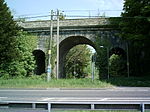Sydling St Nicholas

Sydling St Nicholas is a village and civil parish in Dorset within southwest England. The parish is 5 to 9 miles (8.0 to 14.5 km) northwest of the county town Dorchester and covers most of the valley of the small Sydling Water in the chalk hills of the Dorset Downs. The parish has an area of 2,075 hectares (5,130 acres) and includes the hamlet of Up Sydling in the north. Sydling St Nicholas village was recorded in the 11th-century Domesday Book, though evidence of much earlier human occupation has been found in the surrounding area. Over the last thousand years the village has been owned by Milton Abbey, Sir Francis Walsingham and Winchester College. The whole of Sydling St Nicholas parish lies within the Dorset Area of Outstanding Natural Beauty. In addition, parts of the parish lie within the Hog Cliff National Nature Reserve and the Cerne and Sydling Downs Special Area of Conservation. In the 2011 census the parish had a population of 414.
Excerpt from the Wikipedia article Sydling St Nicholas (License: CC BY-SA 3.0, Authors, Images).Sydling St Nicholas
High Street,
Geographical coordinates (GPS) Address Nearby Places Show on map
Geographical coordinates (GPS)
| Latitude | Longitude |
|---|---|
| N 50.7931 ° | E -2.5239 ° |
Address
High Street
High Street
DT2 9PB , Sydling St. Nicholas
England, United Kingdom
Open on Google Maps







